
1 Department of Business Administration, Aligarh Muslim University, Uttar Pradesh, India

Creative Commons Non Commercial CC BY-NC: This article is distributed under the terms of the Creative Commons Attribution-NonCommercial 4.0 License (http://www.creativecommons.org/licenses/by-nc/4.0/) which permits non-Commercial use, reproduction and distribution of the work without further permission provided the original work is attributed.
As the commercial and environmental landscapes change, the world community has come to accept the idea of a “green economy.” Integrating green ideals into higher education can support a behavioral approach to encouraging green entrepreneurship. Although the importance of entrepreneurship education has been acknowledged, it is still unclear how exactly it would affect students’ intents to start green businesses. Taking into consideration the moderating effect of the environment, this review of the research aims to elucidate the relationship between green entrepreneurial intention and entrepreneurship education. A review of the literature was conducted to determine the connection between ambitions for green entrepreneurship and entrepreneurship education. A theoretical framework for analyzing green entrepreneurial intents is suggested by the results, which is based on the theory of planned behavior. This study is noteworthy because it examines for the first time how environmental values impact the relationship between entrepreneurship education and the three primary determinants of intention: attitudes, subjective norms, and perceived behavioral control.
Entrepreneurial education, entrepreneurship, intention, sustainability, theory of planned behavior
Introduction
The concept of green entrepreneurship has garnered increasing attention from governments, academia, and policymakers as a strategic approach to tackling pressing social and environmental challenges. Over the years, various terms have emerged to define this concept, including enviropreneurship and sustainopreneurship (Huda, 2016; OECD, 2011; Tharindu & Koggalage, 2020), ecopreneurship (Gunawan, 2012), ecological entrepreneurship (Mieszajkina, 2016), environmental entrepreneurship (Huggins, 2013), and sustainable entrepreneurship (Hoogendoorn et al., 2019; Sarango-Lalangui et al., 2018). Despite its growing significance, inconsistencies in its definition and measurement have led to a lack of clarity in fully understanding its core principles (Gevrenova, 2012; Melay & Kraus, 2012; Ye et al., 2020). This ambiguity extends to identifying the key factors influencing individuals’ willingness to engage in green entrepreneurship, making it essential to explore the motivations behind such entrepreneurial activities.
A critical method for assessing green entrepreneurship is through entrepreneurial intention models, as research suggests that entrepreneurial intention serves as a strong predictor of actual entrepreneurial behavior (Bui et al., 2020). The theory of planned behavior (TPB) (Ajzen, 1991) is one of the most widely applied frameworks for understanding the cognitive processes behind entrepreneurial decision-making. However, while TPB provides a strong theoretical foundation, recent studies argue that it does not fully capture the complexity of green entrepreneurial intentions (Nordin, 2020; Vuorio et al., 2018; Yasir et al., 2021). Specifically, TPB falls short in addressing the socio-environmental motivations that drive individuals toward sustainable entrepreneurship. Recognizing these limitations, this study expands on the TPB framework by incorporating entrepreneurship education and sustainable values as key determinants of green entrepreneurial intentions.
Entrepreneurship education is instrumental in developing entrepreneurial mindsets and equipping individuals with essential skills (Sun et al., 2017). While previous studies (Hoang et al., 2020; Shi et al., 2019) have highlighted the significance of entrepreneurship education in fostering general entrepreneurial intentions, limited research has examined its specific influence on green entrepreneurship. This study seeks to fill this gap by investigating how tailored entrepreneurship education, with a focus on sustainability, can cultivate stronger green entrepreneurial intentions.
Additionally, recent global studies suggest that social and environmental values play a crucial role in shaping individuals’ motivations to pursue sustainable business ventures (Peng et al., 2021; Thelken & de Jong, 2020). However, there remains a significant gap in understanding how environmental values interact with entrepreneurship education to influence green entrepreneurial intentions. This study aims to bridge this gap by incorporating environmental values into the entrepreneurial intention model, exploring their moderating effect on the relationship between entrepreneurship education and green entrepreneurial intentions. By doing so, this research introduces a novel perspective that extends prior studies and provides valuable insights into how educational interventions can effectively nurture future green entrepreneurs.
In summary, this research seeks to contribute to the existing literature by addressing key gaps in the study of green entrepreneurial intentions. Unlike previous studies that focus solely on TPB variables, this research emphasizes the role of entrepreneurship education and environmental values in shaping green entrepreneurial intentions. By doing so, it provides a more comprehensive understanding of the factors influencing green entrepreneurship, thus contributing to the literature and offers practical recommendations based on empirical findings for fostering sustainable business practices, which can help create a more supportive environment for aspiring green entrepreneurs.
The following sections of this study will review relevant literature on TPB, green entrepreneurial intentions, entrepreneurship education, and sustainable values setting the foundation for the empirical analysis that follows.
Literature Review and Hypotheses Development
The present study deals with the relationship between green entrepreneurial intention and entrepreneurship education. Green entrepreneurship is a planned behavior that can be molded in college through the study of entrepreneurship. Through the execution of green entrepreneurship, social marketing programs, institutional infrastructure development, and entrepreneurial ecosystems, in addition to universities, have a role in shaping interest in and behavior related to green entrepreneurship. A comprehensive assessment of the literature was conducted on green entrepreneurial intents from 2011 to 2021. The publications were sourced from reliable sources such as SCOPUS, Emerald, ProQuest, and Google Scholar.
From Table 1, it is clear that, the TPB is widely recognized as one of the most extensively applied and validated models for predicting entrepreneurial intentions. Several studies have leveraged TPB to explore the development of non-traditional entrepreneurial intentions, including social entrepreneurship (Teran-Yepez et al., 2020) and green entrepreneurship (Dees, 2017). Given its strong theoretical foundation, the present study focuses specifically on the pre-behavioral component of TPB, which is commonly used in entrepreneurial research.
Within this framework, attitudes toward sustainability, subjective norms, and perceived behavioral control are key factors influencing entrepreneurial intentions. The first two elements assess whether a particular action is perceived as beneficial, while the third determines the feasibility of engaging in that behavior. Each of these factors is shaped by an individual’s level of confidence in the potential benefits of a given action (Ajzen, 1991). This study incorporates the core antecedents of TPB, as follows:
By integrating these elements, the TPB framework provides a structured approach to understanding the cognitive processes that shape green entrepreneurial intentions and supports the development of effective strategies for fostering sustainable entrepreneurship.
Green Entrepreneurial Intention
Krueger (1993) defined “entrepreneurial intention” as the decision to start a business. Entrepreneurial intention is the state of mind that drives a person’s focus, abilities, and actions toward starting a new business (Bui et al., 2020). TPB explains how intentions are created by stating that people always have a rationale for what they do. This theory consists of three main components: attitude (the degree to which people perceive the behavior as favorable or unfavorable), perceived behavioral control (the degree to which people believe the behavior is easy or difficult to perform), and subjective norm (the perceived social pressure to engage in the behavior or not) (Zaremohzzabieh et al., 2019).
The phrase “green entrepreneurial intention” refers to the aspiration of an individual to launch their own company while keeping environmental issues in mind. “Green entrepreneurship” refers, according to Jabarzadeh et al. (2018), to a range of entrepreneurial endeavors that offer ecologically friendly goods and services in order to generate value for the environment and the economy. According to Demirel et al. (2019), green entrepreneurs are individuals who effectively develop business models that address social and environmental issues while also generating financial gains and benefits to society and the environment. Compared to conventional commercial and social entrepreneurship, green entrepreneurship is characterized by its ability to improve the environment; mitigate the adverse impacts of climate change, including rising sea levels and global warming; and exhibit a resolute dedication to reducing environmental degradation and exploitation (Frederick, 2018). It is imperative that businesses encourage ecologically responsible behavior since social and environmental challenges need to be addressed immediately. Green entrepreneurship fosters sustainability and helps to establish a green economy by reducing the negative consequences of entrepreneurial activities on environmental deterioration worldwide.
Entrepreneurship Education
Entrepreneurship education plays a major role in the formation of planned behavior, including intents and activities associated with green entrepreneurship. According to Sun et al. (2017), entrepreneurship education must include essential components such as know-what, know-why, know-who, and know-how to foster students’ entrepreneurial attitudes and intentions. According to Hoang et al. (2020) and Shi et al. (2019), entrepreneurship education can promote entrepreneurial attitudes and intents. Communities’ and colleges’ social marketing initiatives can be quite effective in encouraging people to launch green businesses. The goal of green entrepreneurship social marketing is to operate sustainably and provide students with business ideas. Liguori et al. (2020) discovered that while students may aspire to pursue entrepreneurship as a career, this aspiration is typically frustrated by a lack of resources and assistance. As a result, educational institutions have a responsibility to promote green entrepreneurship and the adoption of ecologically friendly economic methods.
Educational establishments must help students. They can do this by creating awareness campaigns and developing concepts for green business. These institutions offer students opportunities, networks, information, and skills that are all part of educational assistance (Saeed et al., 2015). Students who are exposed to entrepreneurship education during their academic journeys gain invaluable experiences that act as a major motivator for them to seek professions in entrepreneurship. As a result, the entrepreneurial intention model has to incorporate entrepreneurship education as a new variable (Zhang et al., 2019).
Hence, as per above explanations, the following hypotheses have been formulated:
H1: Entrepreneurship education significantly and positively impacts the attitude toward behavior.
H2: Entrepreneurship education does not have a significant impact on subjective norm.
H3: Entrepreneurship education does not have a significant impact on perceived behavioral control.
The Theory of Planned Behavior
Ajzen (1991) established TPB, which explains the relationship between attitudes, beliefs, intentions, and behavior, building on the notion of reasoned action. The concept of reasoned action holds that an individual’s desire to engage in a certain behavior is influenced by two main factors: their attitude toward the behavior and subjective norms. Perceived behavioral control is a brand-new element added to TPB by Ajzen (1991).
Hence, intents and behavior could be predicted using the widely recognized TPB, which is especially useful when examining the intents of entrepreneurs (Solesvik et al., 2012). Empirical research has validated its applicability in describing entrepreneurial attitudes, intentions, and behavior since Kolvereid first introduced it to the field of entrepreneurship (Bui et al., 2020). The idea states that a person’s intention in becoming an entrepreneur is based on their attitude toward entrepreneurship, positive subjective norms about entrepreneurship, and their sense of control over pursuing entrepreneurship (Trivedi, 2016).
Research has shown that TPB can be a helpful tool in predicting the intents and behaviors of business owners in various personal groups (Trivedi, 2016). Research has consistently shown that students’ attitudes toward behavior, subjective norms, and perceived behavioral control have a favorable and significant impact on their intentions to launch their own businesses (Munir et al., 2019; Paray & Kumar, 2020; Peng et al., 2021; Wardana et al., 2020; Yasir et al., 2021). Empirical studies on green entrepreneurship have also confirmed the positive and significant influence of attitude toward behavior, subjective norms, and perceived behavioral control. The aforementioned justifications allow for the formulation of the following hypotheses:
H4: Attitude toward behavior does not have a significant impact on green entrepreneurial intention.
H5: Subjective norm does not have a significant impact on green entrepreneurial intention.
H6: Perceived behavioral control does not have a significant impact on green entrepreneurial intention.
Environmental Values
The relationship between green entrepreneurial intention and entrepreneurial education has been the subject of numerous studies, which has led to the identification of disparities in previous findings. A number of studies have reported no such effect (Galvão et al., 2018; Karimi et al., 2016), but others (Otache, 2019; Paray & Kumar, 2020; Sun et al., 2017; Wardana et al., 2020; Zhang et al., 2019) have found a positive and significant effect of entrepreneurship education on behavior attitudes, subjective norms, and perceived behavioral control.
There is conflicting evidence regarding the effects of attitude, subjective norm, and perceived behavioral control on green entrepreneurial aspirations. A positive and significant relationship between attitude toward behavior and green entrepreneurial intentions has been found in some studies (Nordin, 2020; Peng et al., 2021; Thelken & de Jong, 2020; Vuorio et al., 2018; Yasir et al., 2021); however, no significant relationship has been found in other studies (Hamzah et al., 2016; Sargani et al., 2020). Ranasinghe and Ajward (2019), Nordin (2020), Thelken and de Jong (2020), Londono et al. (2020), Sargani et al. (2020), Yasir et al. (2021), and Peng et al. (2021) all show variations in subjective norm and perceived behavioral control.
To address these disparities, a new variable might be added. Using environmental value as a variable, it is also possible to investigate the relationship between entrepreneurial education and attitudes, subjective norms, and perceived behavioral control. This is in line with TPB, which holds that intentions and behavior are influenced by a variety of factors, including attitudes, subjective standards, perceived behavioral control, values, and beliefs. In the context of green entrepreneurship, environmental value can enhance the norms, attitudes, and control linked to green entrepreneurial behavior (Nave & Franco, 2019; Vesper & Gartner, 1997). The aforementioned justifications allow for the formulation of the following hypotheses:
H7: Environmental values do not have a significant impact on attitude toward behavior.
H8: Environmental Values do not have a significant impact on subjective norm.
H9: Environmental values do not have a significant impact on perceived behavioral control.
Methodology
Based on a detailed analysis of the literature on green entrepreneurial goals, entrepreneurship education, and drawing from TPB, a conceptual framework has been developed. Figure 1 depicts the created diagram that demonstrates the relationship between entrepreneurship education and green entrepreneurial objectives.
Figure 1. Conceptual Model.

According to the conceptual framework, attitudes, subjective norms, and perceived behavioral control are shaped by entrepreneurship education, which in turn influences green entrepreneurial intents. What sets this research review apart from others is the addition of the additional variable of environmental values, which improves the influence of entrepreneurship education on attitudes, norms, and control relevant to green entrepreneurial behavior. In an earlier study, Qazi et al. (2020) also looked into the usage of environmental values as a factor for the influence of attitudes and subjective norms on green entrepreneurial desires. According to Yasir et al. (2021), environmental values have an effect in a stepwise manner, affecting attitudes, norms, behavior control, and intention in turn. Both actual facts and TPB support this.
Questionnaire Development
A closed-ended, structured questionnaire provided the data. The Likert scale (5 points) was used as the basis for the statements of different constructs. With funding from the central government, subject matter experts from a university in India conducted the pilot testing. They recommended that phrases be rephrased and that exploratory factor analysis be used to modify the scales (Hair et al., 2010; Malhotra & Dash, 2011). Entrepreneurial education consisted of five statements: “Entrepreneurship course should be made compulsory in order to stimulate entrepreneurial spirit in campus,” “More entrepreneurial and business educational programs on campus would help students to start businesses,” “The entrepreneurial education and training is enhancing my problem-solving and critical-thinking skills,” “The entrepreneurship course should offer opportunities for hands-on learning (e.g., business simulations, startup projects),” and “If a major in entrepreneurship were available, I will change my major to it.” Environmental values were taken from the scale developed by Kuckertz and Wagner (2010). The Liñán and Chen (2009) scale was used for the questions of attitude, subjective norms, perceived behavioral control, and green entrepreneurial intention.
Sample
Sampling is a critical component of marketing research, ensuring the selection of a representative group from the target population. This study focuses on MBA students in India, whose education in business and entrepreneurship directly influences their entrepreneurial intentions. To maintain sample quality, institutions were selected based on the NIRF Ranking 2023, covering 10 central universities recognized for academic excellence and diversity. Given the study’s focus on entrepreneurial intention, the sample was drawn exclusively from top NIRF-ranked MBA programs, ensuring relevance and rigor. Data was collected via Google Forms, distributed through e-mails and WhatsApp groups. Screening questions ensured the inclusion of only MBA students enrolled in entrepreneurship-related courses. Of the 977 participants, 884 valid responses were recorded for analysis.
Data Analysis
Demographic Analysis
Table 2 displays the demographic profiles of the respondents (884 final samples). There were 884 pupils in the sample, including 31.5% females and 68.5% males. The majority (80%) belonged to middle-class and upper-class groups with yearly incomes of $5,000,00,000 and higher.
Table 1. A Comprehensive Review of Recent Research Examining Entrepreneurial Intention Through the Lens of Theory of Planned Behavior Models.
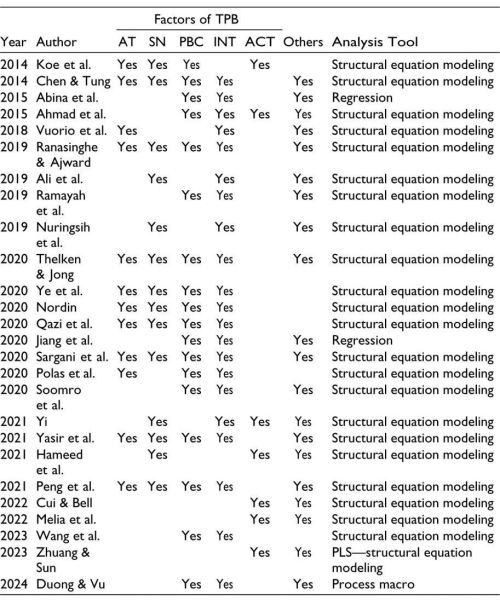
Note: EE, entrepreneurial education; AT, attitude; SN, subjective norm; PBC, perceived behavioral control; INT, intention.
Exploratory Factor Analysis
The responses of the survey were subjected to EFA (Malhotra & Dash, 2011). According to various studies, items having a value of 0.5 or above should be retained (Fen & Sabruddin, 2008; Hair et al., 2006). Therefore, items having loading more than 0.5 were retained in the present study. For a more meaningful factor solution and better interpretation of the factors, factor rotation was employed. Varimax rotation was selected for the present study (Khan & Kirmani, 2018). The results of the retained items are shown in Table 3 and Table 4.
Table 2. Demographic Analysis.

Table 3. Exploratory Factor Analysis.
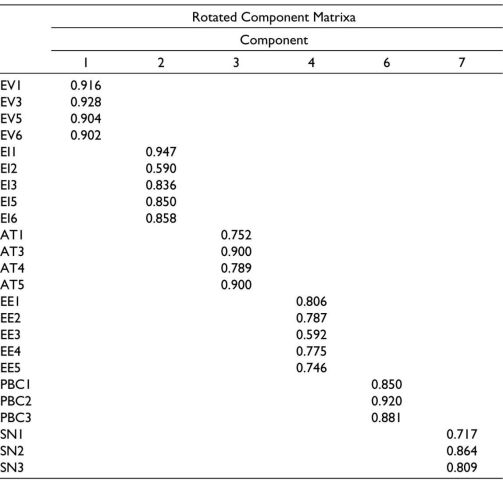
Note: aRotation converged in six iterations; extraction method: principal component analysis; rotation method: Varimax with Kaiser normalization.
It is observed from Table 3 and Table 4 that among six items of EE, one item was dropped. Similarly, two items of EV and PBC and one item of AT, SN, and EI were excluded. The final measurement items are listed in Table 4.
Table 4. Final Measurement Items.
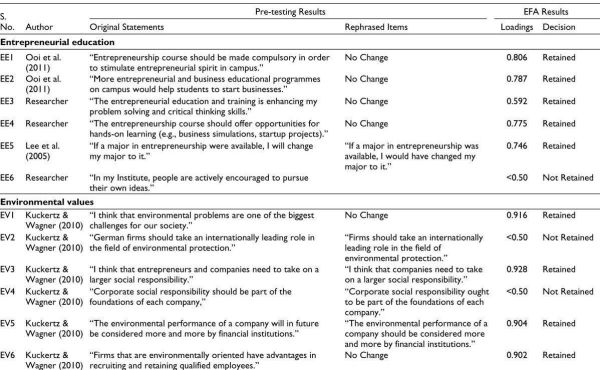
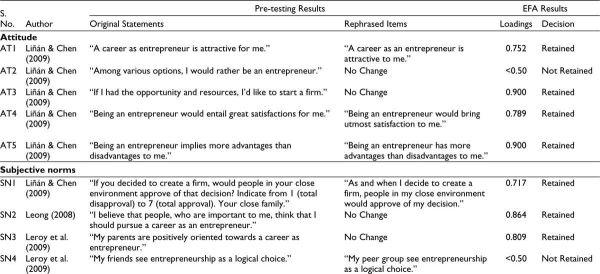
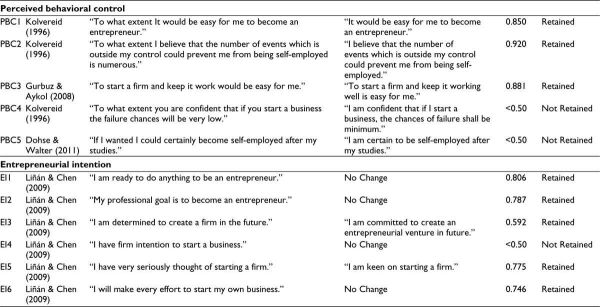
Validity Analysis
The accuracy of the instrument is measured by validity analysis (Linn, 2000). It is the extent to which the test tool accurately measures what it purports to measure. Convergent and discriminant validity are measured while guaranteeing the validity of the construct (Hair et al., 2006). Table 5 presents the validity results, which are described further.
Construct validity backs up the assertion made by the test it is designed to measure. Convergent and discriminant validity, which indicate how the observed items of the proposed model measure a construct they are attempting to assess, are the two elements that go into proving construct validity.
Convergent validity describes the empirical relationship between theoretically linked construct measures (Trochim, 2006). Two determinants—the factor loadings and average variance extracted (AVE)—are evaluated in order to gauge convergent validity (Hair et al., 2010). When the first criterion was used, all of the factors had factor loadings greater than 0.50, as shown by the standardized loadings (Table 3). With values more than 0.50, the second convergent validity determinant, or AVE, which calculates the mean of the variance derived from the item loadings of a construct, was also determined to be acceptable (Hair et al., 2010).
Discriminant validity measures how unconnected the components of the constructs that are intended to be unrelated are. It is ascertained by contrasting the construct’s correlation values with the square root of AVE. Values greater than the correlational values should be found in the square root of AVE. In Table 5, which shows the square root values of AVE, the correlational values are shown in boldface behind the diagonal values. The result suggests that the measure has discriminant validity. Consequently, the construct validity of the scale employed in this study was confirmed.
Table 5. Validity Analysis.

Note: The correlational values are shown in boldface behind the diagonal values.
Structural Equation Modeling
To assess the data, structural equation modeling was employed. The current approach was selected above other possible methods because it provides a clear assessment of measurement errors, uses observed variables to estimate latent variables, and uses fit indices to support model testing (Kaplan, 2001). Within the allowable ranges, the measurement model’s model fit indices are as follows: CMIN/df = 1.970; RMSEA = 0.048; AGFI = 0.919; GFI = 0.938; CFI = 0.855. Additionally, the composite reliability, convergent validity, and discriminant validity (AVE > 0.5, CR close to 0.7, and AVE > MSV) were all within acceptable bounds. The present study’s structural model fit yielded acceptable ranges (CMIN/df = 1.980; RMSEA = 0.049; AGFI = 0.929; GFI = 0.949; CFI = 0.875). Path analysis revealed that each and every hypothesis was supported (Figure 2).
Figure 2. Structural Equation Modeling.
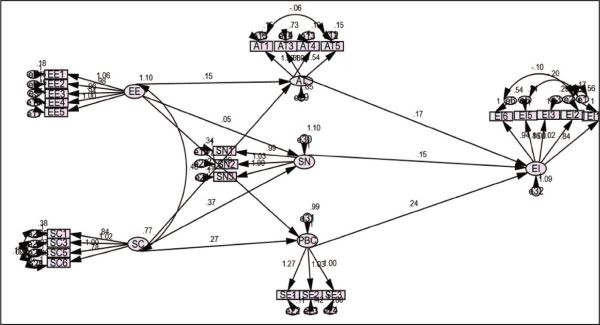
Findings
Together, these insights highlight how education, environmental values, and psychological factors influence green entrepreneurial intentions through attitudes, subjective norms, and perceived behavioral control.
Discussion
The findings highlight the crucial role of entrepreneurship education in fostering green entrepreneurial intentions, emphasizing how educational programs can shape positive attitudes, subjective norms, and perceived behavioral control toward entrepreneurship. By incorporating environmental values into these programs, students gain the knowledge and skills necessary to engage in sustainable business practices. This approach not only encourages entrepreneurial spirit but also aligns it with eco-friendly goals, reflecting the growing demand for businesses that contribute to environmental sustainability. The inclusion of environmental values as a moderating factor further enriches our understanding of how personal environmental beliefs influence entrepreneurial behavior, underscoring the need for education to cultivate environmentally conscious business leaders.
Psychological factors, such as entrepreneurial attitudes, subjective norms, and perceived behavioral control, are also key drivers of green entrepreneurial intentions. Positive entrepreneurial attitudes, reinforced by social support and a strong belief in one’s abilities, significantly increase the likelihood of pursuing green entrepreneurship. These findings highlight the importance of fostering both a supportive societal environment and a sense of self-confidence to encourage individuals to take entrepreneurial action. Together, these insights suggest that education, environmental values, and psychological factors are interconnected in shaping individuals’ entrepreneurial intentions and behaviors, emphasizing the need for programs that support both cognitive and environmental aspects of entrepreneurship.
Implications, Limitations, and Future Research Directions
Implications
On the basis of findings, key implications are listed below:
a. Develop and deliver specialized workshops on business planning, risk management, and innovation.
b. Partner with successful entrepreneurs to provide real-world case studies and hands-on experiences.
c. Include pitch competitions, hackathons, and live startup projects as part of the curriculum.
d. Offer elective courses focused on specific entrepreneurial industries like technology, social entrepreneurship, or green business.
2. Promoting sustainability in entrepreneurship:
a. Provide tax incentives or funding for startups focused on renewable energy, waste reduction, or eco-friendly products.
b. Establish university research centers dedicated to sustainable entrepreneurship, offering grants for innovative projects.
c. Introduce sustainability certification programs for entrepreneurs adopting environmentally conscious practices.
3. Strengthening entrepreneurial attitudes:
a. Launch campaigns emphasizing the economic and personal fulfillment benefits of entrepreneurship.
b. Share testimonials and success stories of entrepreneurs from similar socioeconomic backgrounds to inspire confidence.
c. Create storytelling initiatives that showcase how entrepreneurship has positively impacted communities.
4. Reinforcing subjective norms for sustainability-focused ventures:
a. Develop local “green hubs” or co-working spaces that connect sustainability-minded entrepreneurs and encourage collaboration.
b. Launch public recognition programs to reward and celebrate eco-friendly businesses, motivating others to follow suit.
c. Partner with NGOs to offer training and resources for sustainable business models.
5. Building entrepreneurial perceived behavioral control:
a. Organize regular confidence-building workshops such as public speaking, negotiation, and problem-solving exercises.
b. Provide mentorship programs where experienced entrepreneurs coach and guide aspiring entrepreneurs.
c. Set up mock business simulations where participants experience the challenges and decisions of running a business.
6. Government and institutional support:
a. Establish low-interest loans and microcredit programs specifically for sustainable and faith-driven startups.
b. Simplify licensing and regulatory processes for small businesses to encourage new ventures.
c. Partner with educational institutions to establish entrepreneurship cells that provide resources such as incubators and accelerators.
d. By adopting these targeted actions, stakeholders can effectively address the key findings and create a conducive environment for entrepreneurial growth and sustainable impact.
Limitations of the Study
All efforts have been taken to make the study error free; however, every study creates challenges and issues, some of which remain unexplored, setting the need for further researches. These issues are listed below, which require attention of future researchers:
Directions for Future Research
Some guidance for the researchers in the area of green marketing and social media marketing have been listed below:
Declaration of Conflicting Interests
The authors declared no potential conflicts of interest with respect to the research, authorship, and/or publication of this article.
Funding
The authors received no financial support for the research, authorship, and/or publication of this article.
ORCID iD
Khan Mohd Maaz  https://orcid.org/0009-0005-1684-451X
https://orcid.org/0009-0005-1684-451X
Abina, M. B., Oyeniran, I. W., & Onikosi-Alliyu, S. O. (2015). Determinants of eco entrepreneurial intention among students: A case study of university students in Ilorin and Malete. Ethiopian Journal of Environmental Studies and Management, 8(1), 107–112.
Ahmad, N. H., Halim, H. A., Ramayah, T., & Rahman, S. A. (2015). Green entrepreneurship inclination among Generation Y: The road towards a green economy. Problems and Perspectives in Management, 13(2), 211–218.
Ajzen, I. (1991). The theory of planned behavior. Organizational Behavior and Human Decision Processes, 50(2), 179–211. https://doi.org/10.1016/0749- 5978(91)90020-T
Ali, I., Ali, M., & Badghish, S. (2019). Symmetric and asymmetric modeling of the dynamic relationship between entrepreneurial activity and economic growth in Saudi Arabia. Journal of Entrepreneurship in Emerging Economies, 11(2), 258–281.
Bui, T. H. V., Nguyen, T. L. T., Tran, M. D., & Nguyen, T. A. T. (2020). Determinants influencing entrepreneurial intention among undergraduates in universities of Vietnam. The Journal of Asian Finance, Economics, and Business, 7(7), 369–378.
Chen, M. F., & Tung, P. J. (2014). Developing an extended theory of planned behavior model to predict consumers’ intention to visit green hotels. International Journal of Hospitality Management, 36, 221–230. https://doi.org/10.1016/j.ijhm.2013.09.006
Cui, J., & Bell, R. (2022). Behavioural entrepreneurial mindset: How entrepreneurial education activity impacts entrepreneurial intention and behaviour. International Journal of Management Education, 20(2), 1–16.
Dees, J. G. (2017). The meaning of social entrepreneurship. In Case studies in social entrepreneurship and sustainability (pp. 34–42). Routledge.
Demirel, P., Li, Q. C., Rentocchini, F., & Tamvada, J. P. (2019). Born to be green: New insights into the economics and management of green entrepreneurship. Small Business Economics, 52(4), 759–771.
Dohse, D., & Walter, S. G. (2012). Knowledge context and entrepreneurial intentions among students. Small Business Economics, 39(4), 877–895.
Duong, C.D., & Vu, N.X. (2024). Entrepreneurial education and intention: Fear of failure, self-efficacy and gender. Journal of Small Business and Enterprise Development, 31(4), 629–654. https://doi.org/10.1108/JSBED-02-2023-0057
Fen, Y. S., & Sabaruddin, N. A. (2008). An extended model of theory of planned behaviour in predicting exercise intention. International Business Research, 1(4), 108–122.
Frederick, H. H. (2018). The emergence of biosphere entrepreneurship: Are social and business entrepreneurship obsolete? International Journal of Entrepreneurship and Small Business, 34(3), 381–419.
Galvão, A., Marques, C. S., & Marques, C. P. (2018). Entrepreneurship education and the development of young people life competencies and skills. Journal of Entrepreneurship Education, 21(1), 1–11.?
Gao, L., Wang, S., Li, J., & Li, H. (2017). Application of the extended theory of planned behavior to understand individual’s energy saving behavior in workplaces. Resources, Conservation & Recycling, 127, 107–113.
Gevrenova, T. (2012). Nature and characteristics of green entrepreneurship. Trakia Journal of Sciences, 13(2), 321–323.
Gunawan, A. A. (2012). Ecopreneurship concept and its barriers, a literature review. https//repository.ubn.ru.nl/bitstream/handle/2066/187760/187760pre.pdf
Gürbüz, G., & Aykol, S. (2008). Entrepreneurial management, entrepreneurial orientation and Turkish small firm growth. Management Research News, 31(4), 321–336.
Hair, J. F., Black, W. C., Babin, B. J., Anderson, R. E., & Tatham, R. L. (2006). Multivariate data analysis (6th ed.). Pearson Prentice Hall.
Hair, J. F., Black, W. C., Babin, B. J., & Anderson, R. E. (2010). Multivariate data analysis (7th ed.). Prentice Hall.
Hameed, I., Zaman, U., Waris, I., & Shafique, O. (2021). A serial-mediation model to link entrepreneurship education and green entrepreneurial behavior: Application of resource-based view and flow theory. International Journal of Environmental Research and Public Health, 18(2), 550.
Hamzah, H., Yahya, Z., Sarip, A. G., & Mohd Adnan, Y. (2016). Impact of entrepreneurship education programme (EEP) on entrepreneurial intention of real estate graduates. Pacific Rim Property Research Journal, 22(1), 17–29.
Hoang, G., Le, T. T. T., Tran, A. K. T., & Du, T. (2020). Entrepreneurial self-efficacy and intention among Vietnamese students: A meta-analytic path analysis. Education + Training, 62(2), 225–245.?
Hoogendoorn, B., Zwan, P., & Thurik, R. (2019). Sustainable entrepreneurship: The role of perceived barriers and risk. Journal of Business Ethics. https://doi.org/10.1007/s10551-017-3646-8
Huda, K. (2016). Towards sustainopreneurship development at the tertiary level education: A case study on Southern University Bangladesh. Journal on Innovation and Sustainability, 7, 3–16. https://doi.org/10.24212/2179-3565.2016v7i2p3-16
Huggins, L. E. (2013). Environmental entrepreneurship, markets meet the environment in unexpected places. Edward Elgar Publishing Ltd.
Jabarzadeh, Y., Sarvari, R., & Alghalandis, N. A. (2018). Exploring socio-economic barriers of green entrepreneurship in Iran and their interactions using interpretive structural modeling. International Journal of Industrial and Systems Engineering, 12(3), 392–397.
Jiang, H., Wang, S., Wang, L., & Li, G. (2020). Golden apples or green apples? The effect of entrepreneurial creativity on green entrepreneurship: A dual pathway model. Sustainability, 12(15), 6285.
Kaplan, R. S., & Norton, D. P. (2001). The strategy-focused organization: How balanced scorecard companies thrive in the new business environment. Harvard Business Press.
Karimi, S., Biemans, H. J., Lans, T., Chizari, M., & Mulder, M. (2016). The impact of entrepreneurship education: A study of Iranian students’ entrepreneurial intentions and opportunity identification. Journal of Small Business Management, 54(1), 187–209.
Khan, M. N., & Kirmani, M. D. (2018). Role of religiosity in purchase of green products by Muslim students: Empirical evidences from India. Journal of Islamic Marketing, 9(3), 504–526.
Koe, W. L., Omar, R., & Majid, I. A. (2014). Factors associated with propensity for sustainable entrepreneurship. Procedia—Social and Behavioral Sciences, 130, 65–74. https://doi.org/10.1016/j.sbspro.2014.04.009
Kolvereid, L. (1996). Prediction of employment status choice intentions. Entrepreneurship Theory and Practice, 21(1), 47–57.
Krueger, N. (1993). The impact of prior entrepreneurial exposure on perceptions of new venture feasibility and desirability. Entrepreneurship Theory and Practice, 18(1), 5–21.
Kuckertz, A., & Wagner, M. (2010). The influence of sustainability orientation on entrepreneurial intentions: Investigating the role of business experience. Journal of Business Venturing, 25(5), 524–539.
Lee, S. M., Lim, S. B., & Pathak, R. D. (2005). Culture and entrepreneurial orientation: A multi-country study. International Entrepreneurship and Management Journal, 1(3), 171–192.
Lefebure, C. (2019). Translating letters: Criticism as a perspective for a translator. Applied Translation, 13(1), 32–39. https://appliedtranslation.nyc/index.php/journal/article/view/317
Leroy, H., Palanski, M. E., & Simons, T. (2012). Authentic leadership and behavioral integrity as drivers of follower commitment and performance. Journal of Business Ethics, 107(3), 255–264.
Liguori, E., Winkler, C., Vanevenhoven, J., Winkel, D., & James, M. (2020). Entrepreneurship as a career choice: Intentions, attitudes, and outcome expectations. Journal of Small Business & Entrepreneurship, 32(4), 311–331.
Liñán, F., & Chen, Y. W. (2009). Development and cross-cultural application of a specific instrument to measure entrepreneurial intentions. Entrepreneurship Theory and Practice, 33(3), 593–617.
Linn, R. L. (2000). Assessments and accountability. Educational Researcher, 29(2), 4–16.
Londono, J. C., Wilson, B., & Osorio-Tinoco, F. (2020). The impact of university support on entrepreneurial intention: Evidence from Colombian students. Journal of Entrepreneurship in Emerging Economies, 12(4), 497–517.
Malhotra, N. K., & Dash, S. (2011). Marketing research: An applied orientation (6th ed.). Pearson Education India.
Melay, I., & Kraus, S. (2012). Green entrepreneurship: Definitions of related concepts. International Journal of Strategic Management, 12(2), 1–12.
Melia, A., Maya, M., Anny, N., & Meily, M. (2022). Entrepreneurship education increases entrepreneurial intention among undergraduate students. European Journal of Educational Research, 11, 2, 995–1008.
Mieszajkina, E. (2016). Ecological entrepreneurship and sustainable development. Problemy Ekorozwoju, 12, 163–171.
Munir, H., Jianfeng, C., & Ramzan, S. (2019). Entrepreneurial passion and venture performance: The mediating role of entrepreneurial self-efficacy. Journal of Entrepreneurship in Emerging Economies, 11(3), 350–370.
Nave, A., & Franco, M. (2019). University-firm cooperation as a way to promote sustainability practices: A sustainable entrepreneurship perspective. Journal of Cleaner Production, 230, 1188–1196. https://doi.org/10.1016/j.jclepro.2019.05.195
Nordin, N. (2020). Green entrepreneurial intention of MBA students: A Malaysian study. International Journal of Industrial Management, 5, 38–55.
Nuringsih, K., Nuryasman, M. N., & IwanPrasodjo, R. A. (2019). Sustainable entrepreneurial intention: The perceived of triple bottom line among female students. Jurnal Manajemen, 23(2), 168–190.
OECD. (2011). Measuring green entrepreneurship. Entrepreneurship at a glance.
Ooi, K. B., Lin, B., Teh, P. L., & Chong, A. Y. L. (2011). Are TQM practices supporting customer satisfaction and service quality? Journal of Services Marketing, 25(6), 410–419.
Otache, I. (2019). Entrepreneurship education and undergraduate students’ self- and paid-employment intentions: A conceptual framework. Education + Training, 61(1), 46–64.?
Paray, Z. A., & Kumar, S. (2020). Does entrepreneurship education influence entrepreneurial intention among students in HEI? The role of age, gender and degree background. Journal of Entrepreneurship Education, 23(3), 1–14.
Peng, H., Li, B., Zhou, C., & Sadowski, B. M. (2021). How does the appeal of environmental values influence sustainable entrepreneurial intention? International Journal of Environmental Research and Public Health, 18(3), 1070.
Polas, M. R. H., Hossain, M. I., Tabash, M. I., Karim, A. M., Dad, A., & San, O. T. (2020). Does green entrepreneurial intention persuade an individual to contribute to the sustainable green economy? Journal of Talent Development and Excellence, 12(Suppl 2), 1142–1157.
Qazi, W., Qureshi, J. A., Raza, S. A., Khan, K. A., & Qureshi, M. A. (2020). Impact of personality traits and university support on entrepreneurial intentions: The mediating role of entrepreneurial self-efficacy. Journal of Public Affairs, 20(1), e2123.?
Ramayah, T., Rahman, S. A., & Taghizadeh, S. K. (2019). Modelling green entrepreneurial intention among university students using the entrepreneurial event and cultural values theory. International Journal of Entrepreneurial Venturing, 11(4), 394–412.
Ranasinghe, B., & Ajward, R. (2019). Factors affecting green entrepreneurial intention among small and medium enterprise owners in Western Province, Sri Lanka. In Proceedings of the 12th International Research Conference of General Sir John Kotelawala Defence University (pp. 1–10). General Sir John Kotelawala Defence University (KDU), Sri Lanka.
Saeed, W. S., Yousafzai, S. Y., Yani-De-Soriano, M., & Muffatto, M.(2015). The role of perceived university support in the formation of students’ entrepreneurial intention. Journal of Small Business Management, 53(4), 1127–1145.
Sarango-Lalangui, P., Santos, J. L. S., & Hormiga, E. (2018). The development of sustainable entrepreneurship research field. Sustainability. https://doi.org/10.3390/su10062005
Sargani, G. R., Zhou, D., Raza, M. H., & Wei, Y. (2020). Sustainable entrepreneurship in the agriculture sector: The nexus of the triple bottom line measurement approach. Sustainability, 12(8), 3275.
Schick, H., Marxen, S., & Freimann, J. (2016). Sustainability in the start-up process. In M. Schaper (Ed.), Making ecopreneurs: Developing sustainable entrepreneurship (2nd ed., pp. 108–121). CRC Press.
Shi, L., Yao, X., & Wu, W. (2019). Perceived university support, entrepreneurial self-efficacy, heterogeneous entrepreneurial intentions in entrepreneurship education: The moderating role of the Chinese sense of face. Journal of Entrepreneurship in Emerging Economies, 12(2), 205–230.?
Solesvik, M. Z., Westhead, P., Kolvereid, L., & Matlay, H. (2012). Student intentions to become self-employed: The Ukrainian context. Journal of Small Business and Enterprise Development, 19(3), 441–460.
Soomro, B. A., Ghumro, I. A., & Shah, N. (2020). Green entrepreneurship inclination among the younger generation: An avenue towards a green economy. Sustainable Development, 28(4), 585–594.
Sun, H., Lo, C. T., Liang, B., & Wong, Y. L. B. (2017). The impact of entrepreneurial education on entrepreneurial intention of engineering students in Hong Kong. Management Decision, 55(7), 1371–1393.
Teran-Yepez, E., Marín-Carrillo, G. M., Casado-Belmonte, M., del Pilar Casado-Belmonte, M., & de las Mercedes Capobianco-Uriarte, M. (2020). Sustainable entrepreneurship: Review of its evolution and new trends. Journal of Cleaner Production, 252, 119742.
Tharindu, P. K., & Koggalage, R. (2020). Dynamics of green entrepreneurship concept: A review of literature. Dynamics (pembroke, Ont.), 7, 2458–9403. https://doi.org/10.5281/zenodo.4009946
Thelken, H. N., & de Jong, G. (2020). The impact of values and future orientation on intention formation within sustainable entrepreneurship. Journal of Cleaner Production, 266, 122052. https://doi.org/10.1016/j.jclepro.2020.122052
Trivedi, R. (2016). Does university play significant role in shaping entrepreneurial intention? A cross-country comparative analysis. Journal of Small Business and Enterprise Development, 23(3), 790–811.
Vesper, K. H., & Gartner, W. B. (1997). Measuring progress in entrepreneurship education. Journal of Business Venturing, 12(5), 403–421. https://doi.org/10.1016/S08839026(97)00009-8
Vuorio, A. M., Puumalainen, K., & Fellnhofer, K. (2018). Drivers of entrepreneurial intentions in sustainable entrepreneurship. International Journal of Entrepreneurial Behavior & Research, 24(2), 359–381.?
Wang, X.-H., You, X., Wang, H.-P., Wang, B., Lai, W.-Y., & Su, N. (2023). The effect of entrepreneurship education on entrepreneurial intention: Mediation of entrepreneurial self-efficacy and moderating model of psychological capital. Sustainability, 15(3), 2562. https://doi.org/10.3390/su15032562
Wardana, L. W., Narmaditya, B. S., Wibowo, A., Mahendra, A. M., Wibowo, N. A., Harwida, G., & Rohman, A. N. (2020). The impact of entrepreneurship education and students’ entrepreneurial mindset: The mediating role of attitude and self-efficacy. Heliyon, 6(9), e04922. https://doi.org/10.1016/j.heliyon.2020.e04922
Yasir, N., Mahmood, N., Mehmood, H. S., Babar, M., Irfan, M., & Liren, A. (2021). Impact of environmental, social values and the consideration of future consequences for the development of a sustainable entrepreneurial intention. Sustainability, 13(5), 2648.
Ye, Q., Zhou, R., Anwar, M. A., Siddiquei, A. N., & Asmi, F. (2020). Entrepreneurs and environmental sustainability in the digital era: Regional and institutional perspectives. International Journal of Environmental Research and Public Health, 17(4), 1355.
Yi, G. (2021). From green entrepreneurial intentions to green entrepreneurial behaviors: The role of university entrepreneurial support and external institutional support. International Entrepreneurship and Management Journal, 17(2), 963–979.
Zaremohzzabieh, Z., Ahrari, S., Krauss, S. E., Samah, A. A., Meng, L. K., & Ariffin, Z. (2019). Predicting social entrepreneurial intention: A meta-analytic path analysis based on the theory of planned behavior. Journal of Business Research, 96, 264–276. https://doi.org/10.1016/j.jbusres.2018.11.030
Zhang, F., Wei, L., Sun, H., & Tung, L. C. (2019). Understanding the impact of entrepreneurial orientation on firm performance in the Chinese context: The role of organizational learning and innovation. Journal of Small Business Management, 57(3), 897–917.
Zhuang, J., & Sun, H. (2023). Impact of institutional environment on entrepreneurial intention: The moderating role of entrepreneurship education. International Journal of Management Education, 21(3). https://doi.org/10.1016/j.ijme.2023.10086